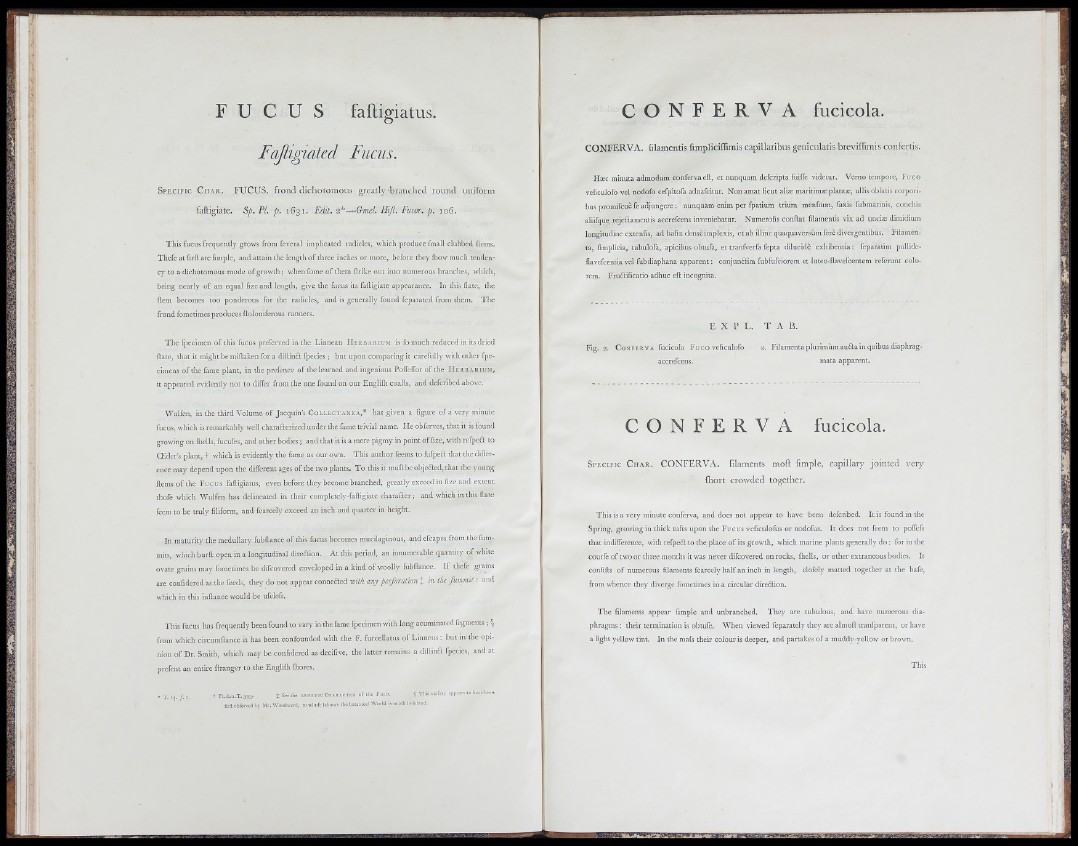
F U C U S faftigiatus.
Fafligiated Fucus.
S p e c i f i c C h a r . FUCUS. fro n d d ich o tom o u s g re a tly -b ran ch e d ro u n d u niform
faftigiate. Sp. PL p. 1 6 3 1 . Edit, a’*“— Gmel. Hiß. Fucor. p. 106,
This fucus frequently grows from feveral implicated radicles, which produce fmall clubbed ilems.
Thefe at firft are fimple, and attain the length o f three inches or more, before they ffiow much tendency
to a dichotomous mode of growth ; when fome o f them ftrike out into numerous branches, which,
being nearly o f an equal fize and length, give the fucus its faftigiate appearance. In this ftate, the
ftem becomes too ponderous for the radicles, and is generally found feparated from them. The
frond fometimes produces ftoloniferous runners.
The fpecimen o f this fucus prcferved in the Linnean H e r b a r i u m is fo much reduced in its dried
ftate, that it might be miftaken for a diftinri fpecies ; but upon comparing it carefully with other fpecimens
of the fame plant, in the prefence of the learned and ingenious PoíToíTor o f the H e r b a r i u m ,
it appeared evidently not to differ from the one found on our Englifh coafts, and defcribed above.
Wulfen, in the third Volume o f Jacquin’s C o l l e c t a n e a , * has given a figure of a very minute
fucus, which is remarkably well chararierized under the fame trivial name. He obferves, that it is found
growing on ihells, fucufes, and other bodies; and that it is a mere pigmy in point o f fize, with refpeft to
CEder’s plant, + which is evidently the fame as our own. This author feems to fufpefl that the difference
may depend upon the different ages of the two plants. To this it muft be objected, that the young
ftems o f the Fucus faftigiatus, even before they become branched, greatly exceed in fize and extent
thofe which Wulfen has delineated in their completely-faftigiate chararier; and which in this ftate
feem to be truly filiform, and fcarcely exceed an inch and quarter in height.
In maturity the medullary fubftance of this fucus becomes mucilaginous, and efcapes from the fummits,
which burft open in a longitudinal direriion. At this period, an innumerable quantity o f white
ovate grains may fometimes be difcovered enveloped in a kind of woolly fubftance. If thefe grains
are confidered as the feeds, they do not appear conneried with any perforation % in ihe fu vm ii: and
which in this inftance would be ufclefs.
This fucus has frequently been found to vary in the fame fpecimen with long acuminated fegments ; §
from which circumftance it has been confounded with the F . furcellatus o f Linneus: but in the opinion
o f Dr. Smith, which may be confidered as dccifive, the latter remains a diftinri fpecies, and at
prefent an entire ftranger to the Englifh fhores.
* T .14 ./ .2 . + Fl.d.r.T.393. t Seethe 02NER.C C h arac te r of the Fucu,. § This v.riciy pppcars lo have bee»
firfl obferved by Mr. Woodward, to whofe labours the botanical World is much indebted.
C O N F E R V A fucicola.
C O N F E R V A , filamentis fimplicifTimis capillaribus geniculatis breviifimis confertis.
Hæc minuta admodùm conferva eft, et nunquam defcripta fuiffe videtur. Verno tempore. Fuco
veficulofo vel nodofo cefpitofa adnafcitur. Non amat ficut aliæ maritimæ plantæ, ullis oblatis corporibus
promifcue fe adjungere : nunqua-m enim per fpatium irium menfium, faxis fubraaririis, conchis
aliifque rejeriamends accrefcens inveniebatur. Numerofis conftat filamentis vix ad unciæ dimidium
longitudine extenfis, ad bafin dense implexis, et ab illinc quaquaversùmferè divergentibus. Filamenta,
fimplicia, tubulofa, apicibus obtufa, et tranfverfa fepta dilucidé exhibentia : feparatim pallide-
flavefcentiavel fubdiaphana apparent; conjunriim fubfufciorem et luteo-flavefcentem referunt colorem.
Fruriificatio adhuc eft incognita.
E X P L . T A B .
Fig. 2. C o n f e r v a fucicola Fuco veficulofo a. Filamenta plurimùm auria in quibus diaphrag-
accrefcens. mata apparent.
C O N F E R V A fucicola.
S p e c if ic C h a r . C O N F E R V A , filaments moil fimple, capillary jointed very
ihort crowded together.
This is a very minute conferva, and does not appear to have been defcribed. It is found in the
Spring, growing in thick tufts upon the Fucus veficulofus or nodofus. It does not feem to poffefs
that indifference, with refperi to the place o f its growth, which marine plants generally do : for in the
courfe o f two or three months it was never difcovered on rocks, ihells, or other extraneous bodies. It
confifts of numerous filaments fcarcely half an inch in length, clofely matted together at the bafe,
from whence they diverge fometimes in a circular direriion.
The filaments appear fimple and unbranched. They are tubulous, and have numerous diaphragms
; their termination is obtufe. When viewed feparately they are almoft tranfparent, or have
a light yellow tint. In the mafs their colour is deeper, and partakes o f a muddy-yellow or brown.
This